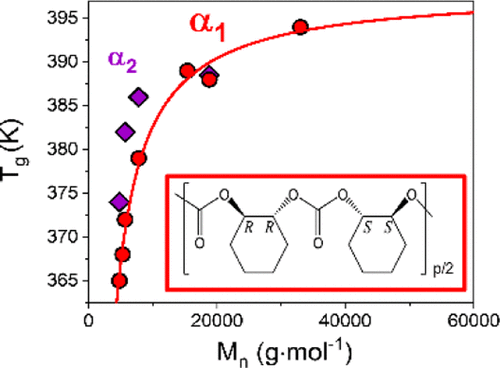当前位置:
X-MOL 学术
›
ACS Appl. Polym. Mater.
›
论文详情
Our official English website, www.x-mol.net, welcomes your
feedback! (Note: you will need to create a separate account there.)
Dynamics of Poly(cyclohexene carbonate) as a Function of Molar Mass
ACS Applied Polymer Materials ( IF 4.4 ) Pub Date : 2022-04-25 , DOI: 10.1021/acsapm.2c00299 Marianna Spyridakou 1 , Christina Gardiner 2 , George Papamokos 1 , Holger Frey 2 , George Floudas 1, 3, 4
ACS Applied Polymer Materials ( IF 4.4 ) Pub Date : 2022-04-25 , DOI: 10.1021/acsapm.2c00299 Marianna Spyridakou 1 , Christina Gardiner 2 , George Papamokos 1 , Holger Frey 2 , George Floudas 1, 3, 4
Affiliation

|
Stereoregular poly(cyclohexene carbonate) (PCHC) homopolymers were prepared via copolymerization of cyclohexene oxide and carbon dioxide (CO2) using (R,R)-(salcy)-CoCl and bis(triphenylphosphine)iminium chloride as a catalyst. The homopolymers had molar masses in the range of 4800–33,000 g mol–1 and relatively narrow dispersity after careful fractionation, as required for the molecular dynamics investigation. We employed differential scanning calorimetry and dielectric spectroscopy, the latter as a function of temperature and pressure, for investigating the thermal properties and the molecular dynamics, respectively. The segmental dynamics in the vicinity of the liquid-to-glass temperature was very complex. The dual segmental processes were inseparable by decreasing the temperature or by increasing the pressure. Based on DFT calculations of the dipole moment, they were ascribed to different stereo sequences of the PCHC backbone. The limiting glass temperature, Tg, for very high molar masses was ∼125 °C. The high Tg value obtained herein well justifies its application as a CO2-based alternative for polystyrene (PS) in a variety of materials based on block copolymers. Moreover, fragility increased with increasing molar mass with values intermediate to poly(styrene) and poly(cyclohexyl methacrylate). The flexible cyclohexyl group in PCHC undergoing intramolecular chair-to-chair conversion increases the packing ability and consequently decreases the fragility. PCHC is a brittle material because it lacks entanglements even for the higher molar masses investigated herein, which is relevant for application as a PS substitute. Within the investigated range of molar masses, the dependences of the terminal relaxation times, τΝΜ, and of the zero-shear viscosity, ηο, on the molar mass, M, are τΝΜ/τSM ∼ M3.2 and ηο ∼ M1.4, revealing an intermediate behavior between Rouse and entangled chains.
中文翻译:

聚(环己烯碳酸酯)的动力学作为摩尔质量的函数
使用( R , R )-(salcy)-CoCl 和双(三苯基膦)亚胺氯化物作为催化剂,通过氧化环己烯和二氧化碳(CO 2 )的共聚制备有规立构聚(碳酸环己烯) (PCHC)均聚物。均聚物的摩尔质量范围为 4800–33,000 g mol –1根据分子动力学研究的要求,仔细分馏后分散度相对较窄。我们采用差示扫描量热法和介电光谱法,后者是温度和压力的函数,分别用于研究热性质和分子动力学。液体到玻璃温度附近的分段动力学非常复杂。通过降低温度或增加压力,双节段过程是密不可分的。基于偶极矩的 DFT 计算,它们归因于 PCHC 主链的不同立体序列。对于非常高的摩尔质量,极限玻璃温度T g为~125°C。高Tg _本文获得的值很好地证明了其在基于嵌段共聚物的各种材料中作为聚苯乙烯 (PS) 的基于CO 2的替代品的应用。此外,脆性随着摩尔质量的增加而增加,其值介于聚(苯乙烯)和聚(甲基丙烯酸环己酯)之间。PCHC 中的柔性环己基进行分子内椅子-椅子转换增加了包装能力,从而降低了脆性。PCHC 是一种脆性材料,因为即使对于本文研究的较高摩尔质量,它也没有缠结,这与作为 PS 替代品的应用相关。在所研究的摩尔质量范围内,末端弛豫时间 τ NΜ和零剪切粘度 η ο,在摩尔质量M上,τ ΝΜ /τ SM ∼ M 3.2和 η ο ∼ M 1.4,揭示了劳斯链和纠缠链之间的中间行为。
更新日期:2022-04-25
中文翻译:

聚(环己烯碳酸酯)的动力学作为摩尔质量的函数
使用( R , R )-(salcy)-CoCl 和双(三苯基膦)亚胺氯化物作为催化剂,通过氧化环己烯和二氧化碳(CO 2 )的共聚制备有规立构聚(碳酸环己烯) (PCHC)均聚物。均聚物的摩尔质量范围为 4800–33,000 g mol –1根据分子动力学研究的要求,仔细分馏后分散度相对较窄。我们采用差示扫描量热法和介电光谱法,后者是温度和压力的函数,分别用于研究热性质和分子动力学。液体到玻璃温度附近的分段动力学非常复杂。通过降低温度或增加压力,双节段过程是密不可分的。基于偶极矩的 DFT 计算,它们归因于 PCHC 主链的不同立体序列。对于非常高的摩尔质量,极限玻璃温度T g为~125°C。高Tg _本文获得的值很好地证明了其在基于嵌段共聚物的各种材料中作为聚苯乙烯 (PS) 的基于CO 2的替代品的应用。此外,脆性随着摩尔质量的增加而增加,其值介于聚(苯乙烯)和聚(甲基丙烯酸环己酯)之间。PCHC 中的柔性环己基进行分子内椅子-椅子转换增加了包装能力,从而降低了脆性。PCHC 是一种脆性材料,因为即使对于本文研究的较高摩尔质量,它也没有缠结,这与作为 PS 替代品的应用相关。在所研究的摩尔质量范围内,末端弛豫时间 τ NΜ和零剪切粘度 η ο,在摩尔质量M上,τ ΝΜ /τ SM ∼ M 3.2和 η ο ∼ M 1.4,揭示了劳斯链和纠缠链之间的中间行为。

































 京公网安备 11010802027423号
京公网安备 11010802027423号